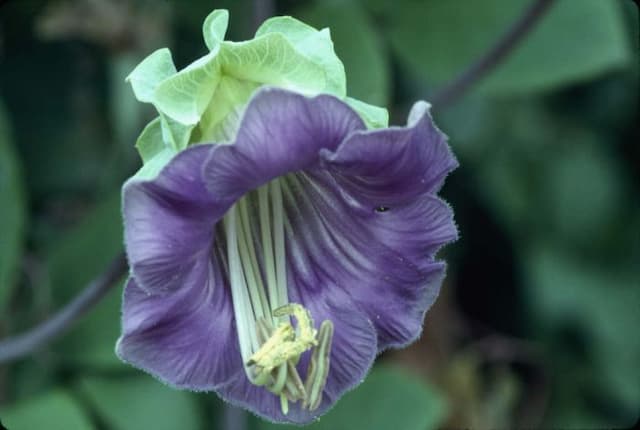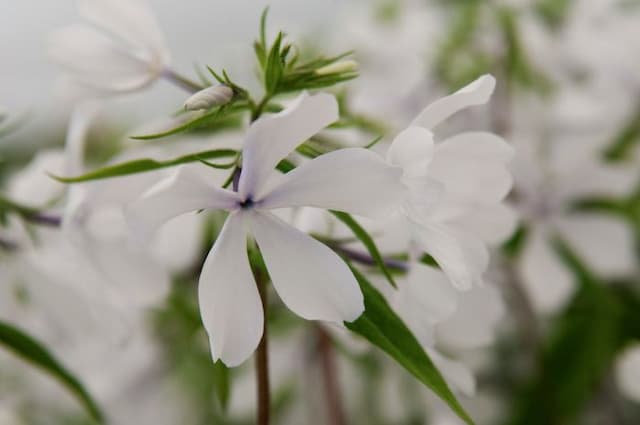Perennial phlox 'Uspekh' Phlox paniculata 'Uspekh'

ABOUT
a herbaceous perennial, up to 1.1m high, with green, lance-shaped leaves and scented, violet-coloured flowers, with a starry white eye, in mid and late summer
About this plant
 Names
NamesFamily
Polemoniaceae
Synonyms
Garden Phlox, Summer Phlox, Fall Phlox, Perennial Phlox
Common names
Phlox paniculata 'Uspekh'.
 Characteristics
CharacteristicsLife cycle
Perennials
Foliage type
Deciduous
Color of leaves
Green
Flower color
Pink
Height
2-4 feet (60-120 cm)
Spread
2-3 feet (60-90 cm)
Plant type
Herb
Hardiness zones
4
Native area
North America
Benefits
 General Benefits
General Benefits- Attracts Pollinators: Phlox paniculata 'Uspekh' (Garden Phlox) is known to attract bees, butterflies, and other beneficial pollinators to the garden, which can help pollinate other plants.
- Aesthetic Appeal: With its vibrant blooms, it adds color and beauty to any garden space or landscape design.
- Fragrance: Garden Phlox has a sweet fragrance that can add a pleasant sensory experience to your outdoor environment.
- Ease of Cultivation: This plant is relatively easy to grow and maintain, making it suitable for gardeners of different skill levels.
- Drought Tolerance: Once established, Phlox paniculata 'Uspekh' has good drought tolerance, reducing the need for frequent watering.
- Cut Flower Use: The blooms make excellent cut flowers for arrangements, bringing the garden's beauty indoors.
- Perennial Growth: As a perennial, it returns year after year, providing a long-term presence and decreasing the need for annual replanting.
- Seasonal Interest: It blooms from mid to late summer, providing seasonal interest during a time when many other plants have finished flowering.
 Medical Properties
Medical PropertiesThis plant is not used for medical purposes.
 Air-purifying Qualities
Air-purifying QualitiesThis plant is not specifically known for air purifying qualities.
 Other Uses
Other Uses- Garden Borders: Phlox paniculata 'Uspekh', commonly known as Garden Phlox, can be used to create vibrant borders in gardens due to its clumping growth habit and colorful blossoms.
- Naturalizing Areas: Garden Phlox can be planted in wildflower meadows or naturalized areas to add color and attract pollinators without requiring much maintenance.
- Companion Planting: Garden Phlox can be used in companion planting schemes to enhance the growth of vegetables and deter pests with its fragrance.
- Themed Gardens: This plant is suitable for use in moon gardens or white-themed gardens, particularly the white-flowering cultivars of Phlox paniculata 'Uspekh'.
- Container Gardening: Due to its compact size, Garden Phlox can be grown in containers to decorate balconies, patios, and other small outdoor spaces.
- Crafting and Dye: The vibrant flowers of Garden Phlox can be used as a natural dye for fabrics or in crafting projects for their color.
- Floral Arrangements: Fresh or dried, the blooms of Phlox paniculata 'Uspekh' can be included in floral arrangements or bouquets, adding height and a splash of color.
- Groundcover: In large planting areas, Garden Phlox can serve as an effective groundcover to suppress weeds and reduce soil erosion.
- Wildlife Garden: By planting Garden Phlox, you can create a habitat that supports butterflies, hummingbirds, and other pollinators crucial for ecosystem health.
- Photography Backdrop: The lush foliage and striking flowers of Garden Phlox make it an excellent backdrop for photography, particularly macro and nature shots.
Interesting Facts
 Feng Shui
Feng ShuiGarden Phlox is not used in Feng Shui practice.
 Zodiac Sign Compitability
Zodiac Sign CompitabilityGarden Phlox is not used in astrology practice.
 Plant Symbolism
Plant Symbolism- Unity: Phlox plants, including Phlox paniculata 'Uspekh', often grow in clusters with numerous flowers, symbolizing the idea of togetherness and harmony.
- Agreement: The growth pattern and the way they fit together is symbolic of consensus and shared views.
- Partnership: Garden phlox, with their collective blooms, are seen to represent collaboration and the joining of forces.
 Water
WaterGarden Phlox should be watered deeply once a week, providing about an inch of water each time. During hot, dry periods, increase watering to twice per week. Avoid overhead watering to prevent foliar diseases, instead, use soaker hoses or drip irrigation to deliver water directly to the base of the plant. Make sure the soil is moist but not waterlogged. Over the course of a month during the growing season, aim to provide approximately 4-6 gallons of water per plant, spread evenly across weekly watering sessions.
 Light
LightGarden Phlox thrives in full sunlight, receiving at least six hours of direct sun each day. The ideal spot for this plant is in an area with bright, unfiltered sunlight, which encourages plentiful blooms and a strong, healthy growth habit. However, in extremely hot climates, Garden Phlox may benefit from light afternoon shade to protect it from the high heat.
 Temperature
TemperatureGarden Phlox prefers a temperate climate with temperatures ranging between 60°F and 85°F for ideal growth. It can withstand temperatures down to about -30°F in winter dormancy. It is important to keep the plant in a location where the temperature does not exceed 90°F for extended periods to prevent stress and potential damage to the plant.
 Pruning
PruningGarden Phlox benefits from pruning to promote vigorous growth and prevent disease. Deadhead spent flowers regularly to encourage a second bloom. After the flowering season, cut back the stems to about 1 to 2 inches above the ground. The best time for this major pruning is in late fall or early spring before new growth begins.
 Cleaning
CleaningAs needed
 Soil
SoilGarden phlox thrives in rich, moist soil with good drainage and a pH of 6.0 to 7.0. A soil mix with compost and loam is ideal for nourishing the plant and supporting its robust growth.
 Repotting
RepottingGarden phlox is a perennial and does not require frequent repotting. It should be divided and replanted every 3 to 4 years to maintain vigor and prevent overcrowding.
 Humidity & Misting
Humidity & MistingGarden phlox prefers moderate humidity levels but is adaptable to various conditions as long as it has good air circulation to prevent disease.
 Suitable locations
Suitable locationsIndoor
Ensure bright light and ample airflow for indoor garden phlox.
Outdoor
Plant in a sunny spot with well-draining soil for outdoor garden phlox.
Hardiness zone
4-8 USDA
 Life cycle
Life cyclePhlox paniculata 'Uspekh', commonly known as garden phlox or perennial phlox, begins its life cycle as a seed sown in early spring or by root cuttings. After germination, the seedlings develop into a rosette of leaves close to the ground, gradually forming a sturdy root system. With sufficient sunlight and nutrients, the plant advances to the vegetative stage, producing tall, erect stems with lanceolate leaves and branching out to create a bushy growth habit. During the summer months, usually between July and September, garden phlox enters the flowering stage, showcasing dense clusters of fragrant, vibrant flowers in hues such as pink, red, purple, or white. After pollination by insects, particularly butterflies and moths, the flowers give way to seed capsules that ripen and release seeds, facilitating the dispersal phase of the life cycle. Garden phlox completes its annual cycle by dying back to the roots in winter, surviving as a perennial with the ability to regenerate and flower in the following growing season.
 Propogation
PropogationPropogation time
Late Spring to Early Summer
The most popular method of propagation for Phlox paniculata 'Uspekh', commonly known as Garden Phlox, is by division. This technique is usually performed in early spring or late summer after the blooming period. Gardeners dig up the plant, gently separating the root ball into sections, each with a portion of roots and shoots. These divisions should be replanted promptly at the same depth they were growing at before, spaced approximately 15 to 18 inches (about 38 to 46 centimeters) apart to allow ample room for growth. Water the new divisions thoroughly after planting to help establish them. This method of propagation helps to rejuvenate older clumps that may have become woody and less floriferous.









